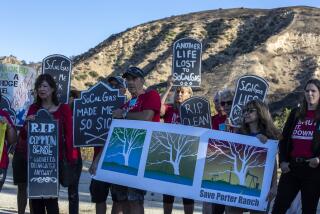Settlement Proposed in Chevron, Santa Barbara Dispute
- Share via
SANTA BARBARA — In an unusual bit of federal intervention, Energy Secretary James D. Watkins offered an 11th-hour plan Friday to settle a dispute between Santa Barbara County and Chevron Corp. over the company’s request to move oil by tanker from one of the largest untapped remaining U.S. oil reserves.
The proposal comes just before the county Board of Supervisors meets Monday to decide a request by Chevron to ship oil from the much-delayed, $2-billion Point Arguello offshore project.
Granting the request would remove the last obstacle to production of up to 75,000 barrels of oil daily from the project, which sits idle despite completion nearly three years ago.
Watkins’ proposal appeared designed to overcome recommendations by county staff that the supervisors reject the request. It echoed, in part, positions argued by Chevron.
“With the Gulf crisis bringing everything to a head in terms of supply, this is an important source of oil,” said Frank Bay, a Department of Energy official, at a news conference here Friday. “From an energy and national security standpoint, we want to see this oil come on line.”
In a statement, Watkins said the proposal grew out of talks with all parties and should meet the county’s environmental concerns, Chevron’s desire to start production and the nation’s need to reduce dependence on foreign oil. Its key provisions would:
* Move 20,000 barrels of oil a day by pipeline from a terminal at Gaviota to refineries elsewhere. The proposal would agree with the method endorsed by county staff, but for less oil than the staff recommends. The rest would be shipped by tanker.
* Have Chevron and other project sponsors agree to stop tankering oil after four years, whether an alternative transportation method becomes available or not. Chevron has previously offered a four-year deadline of its own.
* Commit project sponsors to develop a pipeline to move oil from Point Arguello to refineries in Los Angeles, although failure to do so would not be an excuse to extend tankering beyond the four-year limit.
Watkins’ proposal also urged the county board to accept an environmental impact report as complete, echoing Chevron’s position but contradicting county staff recommendations.
Chevron, acting on behalf of a consortium of 18 oil companies, welcomed Watkins’ proposal. “They’ve talked to us, and we’ve fully briefed them on our problems,” said Richard T. Hughes, Chevron’s district land supervisor. “But it’s their proposal.”
But an oil company critic said the proposal puts unfair pressure on the county. “It’s not an appropriate thing to do,” said Henry Feniger, president of Get Oil Out (GOO), a citizens group that opposes offshore drilling.
One county supervisor said the proposal came as a complete surprise, but added it should not unduly influence the board.
Supervisor Gloria M. Ochoa said the board will listen to the proposal but will reserve the right to make up its own mind. She added she was leaning toward rejecting the permit request.
The Department of Energy got involved in the local dispute after the Iraqi invasion of Kuwait spurred new interest in domestic oil supplies.
If the board approves the tanker permit, Hughes said it would take six months before oil would be produced from Point Arguello. An average output of 75,000 barrels a day could be reached in the second year of production.
If the county rejects the permit request, Chevron will appeal to the state Coastal Commission, and perhaps take the matter to court, Hughes said.
The project has sat idle since completion in December, 1987. The company abandoned a plan to build a pipeline from its Gaviota terminal to Los Angeles when local communities vigorously opposed the proposal.
An earlier permit to tanker oil, granted by the Santa Barbara County Supervisors in May, 1989, was revoked by the state Coastal Commission in August, 1989, after an appeal by GOO and others.
In October, 1989, Chevron sued the Coastal Commission, challenging its action. Meanwhile, it filed a new request with the county for an interim tankering permit.
County staff recommended rejection of the request after a county planning commission meeting Oct. 25 of this year.
Among other things, the staff found that Chevron had not provided sufficient information about a new proposal for a Gaviota-to-Los Angles pipeline--this time using railroad rights-of-way to avoid opposition from local municipalities.
A supplemental environmental impact report did not discuss the proposal, which is necessary before approval can be granted, said Nancy Minick, a county energy specialist. Chevron argued the report was complete as is.
Times staff writer Miles Corwin contributed to this story from Santa Barbara.
More to Read
Sign up for Essential California
The most important California stories and recommendations in your inbox every morning.
You may occasionally receive promotional content from the Los Angeles Times.










